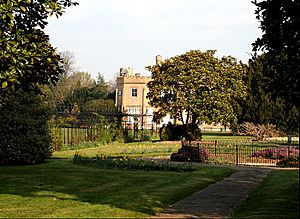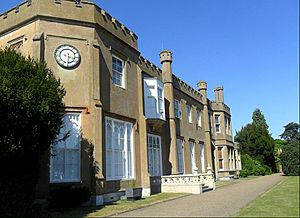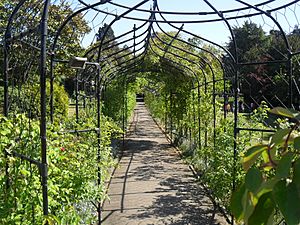Nonsuch Park facts for kids
Quick facts for kids Nonsuch Park |
|
|---|---|

Trees in Nonsuch Park
|
|
| Lua error in Module:Location_map at line 420: attempt to index field 'wikibase' (a nil value). | |
| Type | Public park |
| Location | Epsom and Ewell, Surrey, England |
| Operated by | Epsom and Ewell and London Borough of Sutton joint management committee |
| Status | Open year round |
For the original Tudor Palace that stood in Nonsuch Park, see Nonsuch Palace.
Nonsuch Park is a big public park located between Stoneleigh, North Cheam, Cheam, and Ewell in England. It's on the edge of two areas: Epsom and Ewell and the London Borough of Sutton. This park is the last remaining part of what was once called the Little Park of Nonsuch. This was a special deer hunting park created by Henry VIII around his amazing Nonsuch Palace. Another larger area nearby, called the Great Park of Nonsuch, later became known as Worcester Park.
Inside Nonsuch Park, you'll find a grand building called Nonsuch Mansion, also known as Nonsuch Park House. If you like to run, every Saturday there's a 5-kilometre event called Nonsuch Parkrun that takes place right here in the park!
Contents
Nonsuch Park: A Royal Playground
A Park with a Past
Nonsuch Park has a long and interesting history! People have lived in or near this area for thousands of years.
Ancient Times
Archaeologists have found signs of a possible Iron Age settlement (a very old village) on the south side of the park. They found old pottery and tools, suggesting people lived here around 2,500 years ago.
A famous Roman road called Stane Street also ran along the edge of what is now Nonsuch Park. This road connected London to other important towns.
The Lost Village of Cuddington
Believe it or not, a whole village called Cuddington used to be where Nonsuch Park is today! It was mentioned in the Domesday Book back in 1086. This medieval village had houses, a mill, and even a church.
An old trackway, possibly from Roman or medieval times, still runs through the park. It's now a sunken path, but it was once a busy route through Cuddington village.
Henry VIII's Amazing Palace
In 1538, something huge happened: Henry VIII decided to build a magnificent palace right where Cuddington village stood. He had the entire village, including its church and manor house, completely taken down to make way for his new project.
He named it "Nonsuch" because he claimed there was "none such place like it" anywhere else in Europe! It was meant to be the most incredible palace. Sadly, Henry VIII died in 1547 before it was finished. Much later, around 1682, the palace was pulled down, and its building materials were sold off to pay debts.
What the Palace Was Like
A visitor named Paul Hentzner wrote about the palace in 1598. He said it was surrounded by beautiful parks full of deer, lovely gardens, and shaded walks. He described amazing fountains with water spouting from them, and even one with small birds that streamed water from their beaks! He also mentioned a fountain showing a story from Greek myths. He truly believed the name "Nonesuch" was perfect because it was "without an equal."
Even Samuel Pepys, a famous diarist, visited the area many times in the 1600s. He described the park's trees and even wrote about his little dog chasing sheep there!
Finding the Palace Today
In 1959, archaeologists started digging and found the exact spot where Nonsuch Palace stood. Today, you can see three small stone columns in the park that mark the palace's location. They have maps showing the palace's layout. The shapes of the old palace gardens can still be seen in the different fields and areas of the park.
You can also see the site of the old banqueting house, a separate building where feasts were held. It was taken down a long time ago, but a low wall was rebuilt in the 1800s using some of the original Tudor bricks.
Nonsuch Mansion and More
The park is home to Nonsuch Mansion, also known as Nonsuch Park House. This grand house was built in the mid-1700s and later made even bigger in a Tudor Gothic style. It's considered a very important historic building.
There used to be a chalk quarry (a place where chalk was dug out) in the mansion's gardens. It's thought this quarry might have provided chalk to help build Nonsuch Palace!
In the west of the park, there was also a pottery where clay was dug up to make bricks. This pottery was active for many years, but it's no longer there. Today, part of that area is used for BMX ramps!
Nonsuch Park Today
Nonsuch Park and the Mansion are looked after by the Epsom and Sutton Councils. They bought the land in 1937 to protect it from being built on, making it part of the Metropolitan Green Belt – a special area of open land around London.
At the southern end of the park, you can see concrete foundations from a road that was never finished. Beyond this is Warren Farm, an open space that belongs to the Woodland Trust. A long walking path called the London Loop goes through both Warren Farm and Nonsuch Park.
In the western part of the park, there's an area known as "Devil's Dyke." This spot, which was once a clay pit, has been used by local BMX riders for over 30 years! It's now fenced off but you can still see it from nearby paths.
Nonsuch Parkrun
Since September 2011, Nonsuch Park has hosted its own Parkrun. This is a free, weekly 5-kilometre (about 3.1 miles) run that happens every Saturday morning. It's a great way for people of all ages and abilities to get active!
The Nonsuch Parkrun starts and finishes near the Mansion house at 9 AM. It's a two-lap course that goes along paths and across grass. As of June 2014, over 140 Parkruns had taken place here. The fastest male runner completed the course in just 15 minutes and 7 seconds, and the fastest female runner in 17 minutes and 27 seconds!
Sometimes, if the weather is bad or the grass needs a break, they use a different course. This "Course B" is also 5 km long but is a three-lap route. For example, in February 2014, there were no Parkruns because the course was too wet after a very rainy winter.







